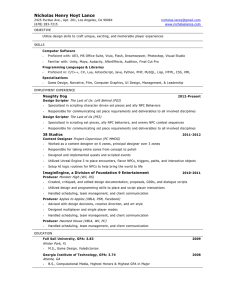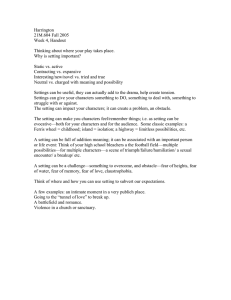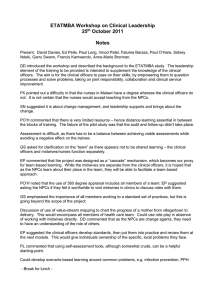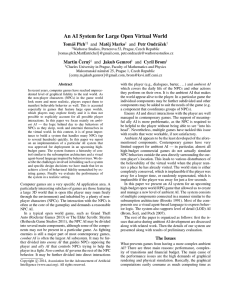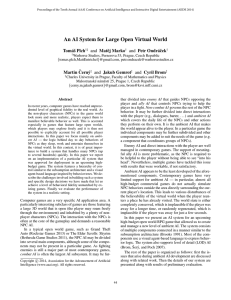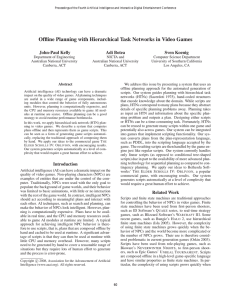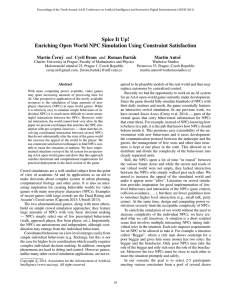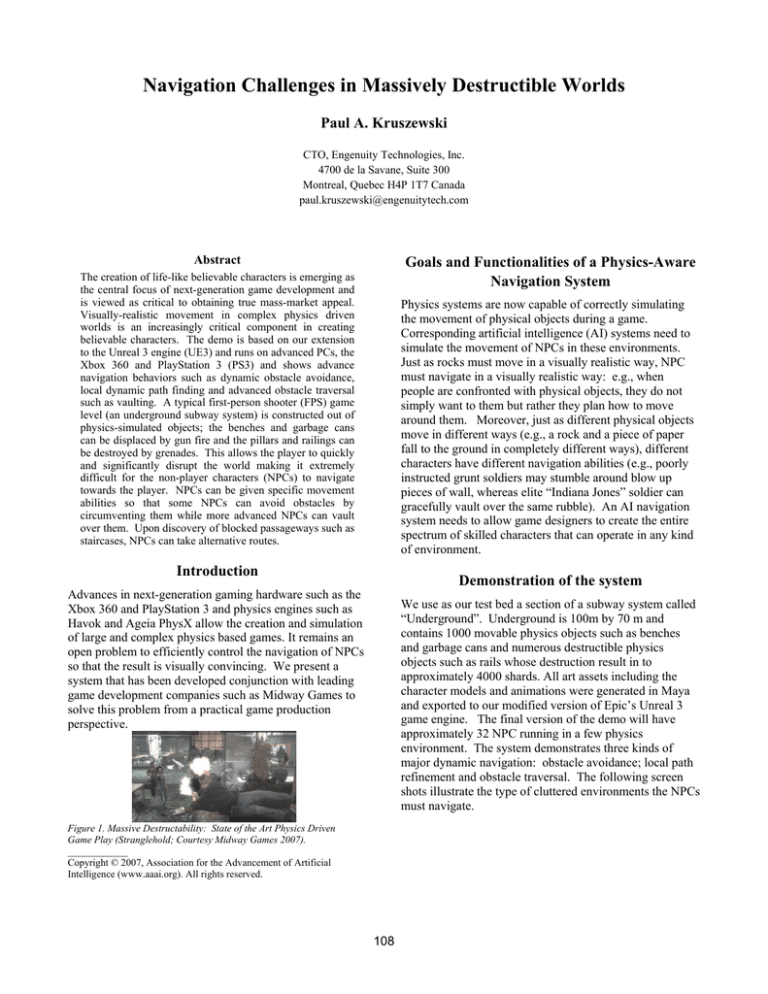
Navigation Challenges in Massively Destructible Worlds
Paul A. Kruszewski
CTO, Engenuity Technologies, Inc.
4700 de la Savane, Suite 300
Montreal, Quebec H4P 1T7 Canada
paul.kruszewski@engenuitytech.com
Abstract
Goals and Functionalities of a Physics-Aware
Navigation System
The creation of life-like believable characters is emerging as
the central focus of next-generation game development and
is viewed as critical to obtaining true mass-market appeal.
Visually-realistic movement in complex physics driven
worlds is an increasingly critical component in creating
believable characters. The demo is based on our extension
to the Unreal 3 engine (UE3) and runs on advanced PCs, the
Xbox 360 and PlayStation 3 (PS3) and shows advance
navigation behaviors such as dynamic obstacle avoidance,
local dynamic path finding and advanced obstacle traversal
such as vaulting. A typical first-person shooter (FPS) game
level (an underground subway system) is constructed out of
physics-simulated objects; the benches and garbage cans
can be displaced by gun fire and the pillars and railings can
be destroyed by grenades. This allows the player to quickly
and significantly disrupt the world making it extremely
difficult for the non-player characters (NPCs) to navigate
towards the player. NPCs can be given specific movement
abilities so that some NPCs can avoid obstacles by
circumventing them while more advanced NPCs can vault
over them. Upon discovery of blocked passageways such as
staircases, NPCs can take alternative routes.
Physics systems are now capable of correctly simulating
the movement of physical objects during a game.
Corresponding artificial intelligence (AI) systems need to
simulate the movement of NPCs in these environments.
Just as rocks must move in a visually realistic way, NPC
must navigate in a visually realistic way: e.g., when
people are confronted with physical objects, they do not
simply want to them but rather they plan how to move
around them. Moreover, just as different physical objects
move in different ways (e.g., a rock and a piece of paper
fall to the ground in completely different ways), different
characters have different navigation abilities (e.g., poorly
instructed grunt soldiers may stumble around blow up
pieces of wall, whereas elite “Indiana Jones” soldier can
gracefully vault over the same rubble). An AI navigation
system needs to allow game designers to create the entire
spectrum of skilled characters that can operate in any kind
of environment.
Introduction
Demonstration of the system
Advances in next-generation gaming hardware such as the
Xbox 360 and PlayStation 3 and physics engines such as
Havok and Ageia PhysX allow the creation and simulation
of large and complex physics based games. It remains an
open problem to efficiently control the navigation of NPCs
so that the result is visually convincing. We present a
system that has been developed conjunction with leading
game development companies such as Midway Games to
solve this problem from a practical game production
perspective.
We use as our test bed a section of a subway system called
“Underground”. Underground is 100m by 70 m and
contains 1000 movable physics objects such as benches
and garbage cans and numerous destructible physics
objects such as rails whose destruction result in to
approximately 4000 shards. All art assets including the
character models and animations were generated in Maya
and exported to our modified version of Epic’s Unreal 3
game engine. The final version of the demo will have
approximately 32 NPC running in a few physics
environment. The system demonstrates three kinds of
major dynamic navigation: obstacle avoidance; local path
refinement and obstacle traversal. The following screen
shots illustrate the type of cluttered environments the NPCs
must navigate.
Figure 1. Massive Destructability: State of the Art Physics Driven
Game Play (Stranglehold; Courtesy Midway Games 2007).
____________
Copyright © 2007, Association for the Advancement of Artificial
Intelligence (www.aaai.org). All rights reserved.
108
DPR then does a local search on the free space defined by
the navigation graph that results from the polygon hulls.
Figure 5. Initial path
before DPR.
Figure 6. Interim local
search graph based on
polygon hulls.
Figure 7. Final
motion trail.
Obstacle Kicking and Traversal
Of course, circumventing obstacles is not only way to deal
with obstacles that are blocking a NPC, alternative
strategies can include kicking (or shooting) obstacles out of
the way or jumping over them. Our system has a notion of
frustration. This allows the system to know when its
progress is being impeded. A call back mechanism
informs the higher level AI system of what is blocking its
progress, given this information the higher level brain can
decide to seek out an alternative route or merely kick it out
of the way (e.g., a small box). Jumping over an obstacle
can be another strategy. For this to work with the game
animation system, typically the NPC needs to line itself up
a specific spot and location on the vaultable object so that
the animation system can play a clean animation clip.
Figure 2, 3. NPCs can either go around or jump over the physics-driven
objects such as barrels, benches, and shattered walls.
Obstacle Avoidance
Our obstacle avoidance system was originally influenced
by Craig Reynold’s seminal work steering behaviours.
Since then it has been highly optimized and made
significantly more robust.
Figure 8. Kicking obstacles out of the
way.
Figure 9. Jumping over obstacles.
References
Reynolds, C. 1987. Flocks, herds, and schools: A
distributed behavior model. In Proceedings of
ACMSIGRAPH 87, Annual Conference Series, ACM
SIGGRAPH.
Figure 4. Resulting motion trail generated by obstacle avoidance.
Dynamic Local Path Refinement
Acknowledgements
Steering behaviours are relatively efficient as they only
look forward for their avoidance, however this implies that
NPCs can be caught in local minimum, especially when the
obstacles are not circular in shape. In order to overcome
these limitations, we can developed system called dynamic
path refinement (DPR). DPR calculates polygon hull
around objects that are blocking the NPC along its path.
The AI.implant system is the result of many years of hard
teamwork. The author would like to thank the entire
AI.implant development team at ETI for its ongoing
excellent work. Copyright © 2007, American Association
for Artificial Intelligence. All rights reserved.
109


